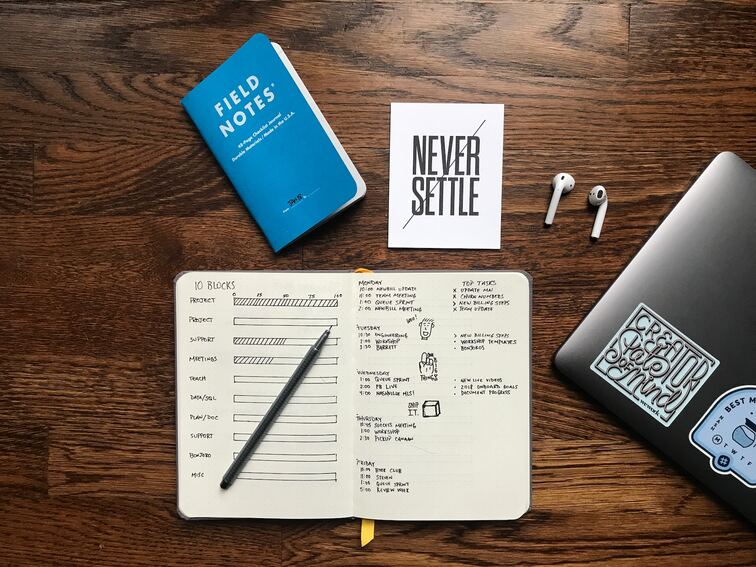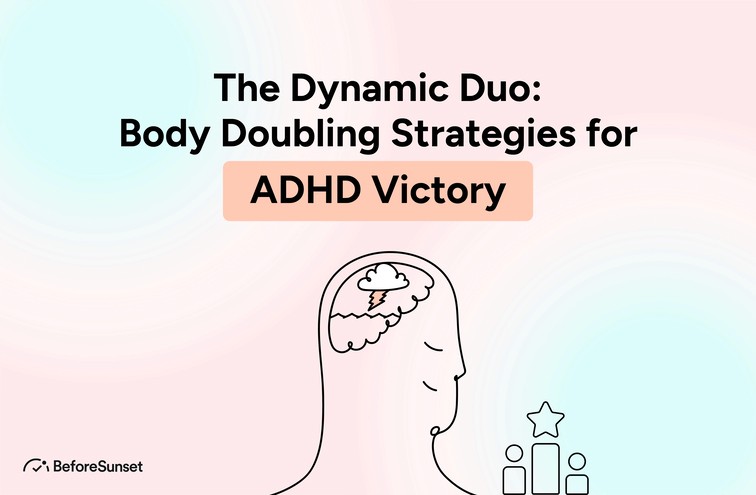When it comes to conquering the obstacles presented by Attention Deficit Hyperactivity Disorder (ADHD), people frequently find comfort and support in creative approaches that promote concentration and efficiency.
The dynamic pair of "Body Doubling" techniques stand out among these tactics as a potent ally in the fight against ADHD. This manual delves into the life-changing potential of utilizing a companion's supporting presence, whether in person or digitally, to improve focus, control distractions, and handle the day-to-day challenges associated with ADHD.
This blog seeks to provide people, caregivers, and educators with a dynamic tool to not only manage the specific characteristics of ADHD but also to thrive and achieve success by exploring the ideas, advantages, and real-world applications of body doubling.
Accompany us on an expedition to unleash the possibilities of the dynamic pair - Body Doubling Techniques for ADHD Triumph.

The Relationship Between Body Doubling and ADHD
A useful tactic for those with Attention Deficit Hyperactivity Disorder (ADHD) is body doubling. ADHD is typified by impulsive behavior, hyperactivity, and trouble maintaining focus, all of which can hinder productivity and job completion.
Some of these difficulties are addressed by the idea of body doubling, which offers a nurturing setting. For those with ADHD, having an additional person around can help establish structure, responsibility, and focus—even if they are not working on the same job directly.
A body double's presence can improve focus, lessen distractions, and lessen the propensity to put things off. Body doubling capitalizes on the psychological advantages of shared commitment, whether in a physical environment with a coworker or virtually during a coworking session.
As such, it may be a useful tactic for ADHD sufferers looking to increase their productivity and task management abilities.
Benefits of Body Doubling for Those with ADHD
Increased Focus and Attention: The presence of a body double can help individuals with ADHD stay focused on tasks by providing a structured and supportive environment. The external presence serves as a cue for sustained attention.
Accountability: Having a body double creates a sense of accountability, motivating individuals to stay on task and complete activities. This can be particularly helpful for individuals with ADHD who may struggle with impulsivity and distractions.
Reduced Procrastination: The supportive presence of a body double can help individuals with ADHD overcome procrastination tendencies. The shared environment encourages a commitment to work and minimizes the likelihood of delaying tasks.
Minimized Distractions: The body double can act as a buffer against potential distractions. The shared space or virtual co-working environment fosters a sense of focus and discourages impulsive shifts in attention.
Structured Routine: Incorporating body doubling into a routine provides a structured approach to work, which can be beneficial for individuals with ADHD who may thrive in environments with clear expectations and external support.
Social Interaction: For those who may struggle with feelings of isolation or loneliness, body doubling provides a form of social interaction without requiring direct collaboration. This can contribute to a positive work atmosphere and improved well-being.
Adaptability: Body doubling can be adapted to various settings, including physical co-working spaces or virtual environments through video calls. This flexibility allows individuals with ADHD to choose the format that best suits their needs.
Improved Time Management: The presence of a body double can serve as a time management tool. It helps individuals stay aware of the passage of time and encourages a more structured approach to task completion.

How to Implement a Body Doubling Program for ADHD Patients
One effective way to help people with Attention Deficit Hyperactivity Disorder (ADHD) improve their attention, productivity, and general well-being is to put in place a body doubling program. Examining efficacious therapies is crucial since concentration, impulsivity, and task management are among the difficulties associated with ADHD.
When a supporting partner is present during work or study sessions, distractions are reduced and focus is encouraged, as part of a body doubling program.
Finding an Accountability Partner or Support Group
1. Identify Your Goals:
Clearly define your goals and objectives. Whether they're related to work, fitness, personal development, or any other area, having a specific focus will help you find a suitable accountability partner or group.
2. Assess Personal Preferences:
Consider your communication preferences, such as whether you prefer in-person meetings, virtual interactions, or a combination of both. This will help narrow down the options when searching for a partner or group.
3. Ask Friends and Family:
Start by reaching out to friends, family members, or colleagues who share similar goals or interests. They may be interested in being your accountability partner, or they might know someone who is.
4. Online Platforms:
Explore online platforms and communities dedicated to specific goals or interests. Websites, forums, and social media groups can connect you with like-minded individuals seeking accountability partners or group support.
5. Meetup Groups:
Attend local Meetup events or search for groups in your area that align with your goals. Meetup is a platform that facilitates in-person gatherings for people with similar interests.
6. Professional Networks:
If your goals are professional in nature, consider joining industry-specific associations, networking groups, or mentorship programs. These can provide both accountability and valuable guidance.
7. Utilize Apps and Platforms:
There are several apps and platforms designed to connect individuals with similar goals. Apps like Focusmate facilitate virtual co-working sessions, while others like MyFitnessPal focus on health and wellness goals.
8. Be Clear About Expectations:
Clearly communicate your expectations and preferences with your potential accountability partner or group. Discuss how often you'll check-in, the preferred mode of communication, and the level of support needed.
9. Join Supportive Communities:
Seek out communities that offer support, encouragement, and resources related to your goals. Online forums, social media groups, or local community centers can be excellent places to find supportive networks.

Establishing Goals and Strategies for Productivity
1. Define Clear and Specific Goals:
Start by identifying specific, measurable, achievable, relevant, and time-bound (SMART) goals. Clearly define what you want to achieve and break larger objectives into smaller, manageable tasks.
2. Prioritize Your Goals:
Determine the importance and urgency of each goal. Prioritize tasks based on their impact and deadlines. This helps you focus on what matters most and avoid feeling overwhelmed.
3. Break Down Goals into Actionable Tasks:
Divide each goal into actionable steps. Breaking down larger goals into smaller tasks makes them more achievable and allows for a sense of progress with each completed step.
4. Set Realistic Expectations:
Be realistic about what you can accomplish within a given timeframe. Setting overly ambitious goals can lead to burnout and frustration. Consider your available resources and time constraints.
5. Use the 2-Minute Rule:
If a task takes less than two minutes to complete, do it immediately. This helps clear small, quick tasks from your to-do list and prevents them from accumulating.
6. Time Blocking:
Allocate specific blocks of time for different tasks. This technique helps minimize multitasking and allows you to focus entirely on one type of activity during a designated period.
7. Implement the Pomodoro Technique:
Break your work into intervals (typically 25 minutes) separated by short breaks. This method, known as the Pomodoro Technique, can enhance focus and prevent burnout.
Utilizing Virtual or Online Bodies as Alternatives to In-Person Sessions
1. Video Conferencing Platforms:
Use video conferencing tools like Zoom, Microsoft Teams, or Google Meet to simulate a virtual co-working environment. Participants can see and hear each other, creating a sense of shared presence.
2. Scheduled Virtual Sessions:
Establish scheduled virtual co-working sessions where participants commit to working on their individual tasks simultaneously. This shared commitment can enhance accountability and focus.

Learning Techniques to Manage Tedious Tasks and Repetitive Behaviors
Managing tedious tasks effectively is crucial for maintaining productivity and preventing burnout. One technique is to break down large and monotonous tasks into smaller, more manageable components. By focusing on one aspect at a time, individuals can make steady progress without feeling overwhelmed.
Additionally, implementing the "Pomodoro technique" can be beneficial, involving short, focused bursts of work followed by brief breaks. Setting specific time limits for tedious tasks helps maintain concentration and prevents mental fatigue. Rewarding oneself after completing a particularly tedious task can also provide motivation and create a positive association with the work.
Managing repetitive behaviors, especially those associated with conditions like obsessive-compulsive disorder (OCD) or certain neurodevelopmental disorders, requires specialized strategies.
Cognitive-behavioral therapy (CBT) is often employed to help individuals understand and modify repetitive thought patterns and behaviors. Exposure and response prevention, a type of CBT, gradually exposes individuals to the source of their obsession and prevents the accompanying compulsion, promoting habituation and reduced anxiety.
Mindfulness techniques, such as meditation and deep breathing, can also be effective in managing repetitive behaviors by fostering awareness and interrupting automatic responses.
Establishing alternative, healthier habits to replace repetitive behaviors is another key component of successful management. Overall, a combination of therapeutic approaches tailored to individual needs is often the most effective way to address and manage repetitive behaviors.
How Can BeforeSunset AI Help You?
At BeforeSunset AI, we understand the struggles of ADHD and feel that everyone deserves a chance to succeed. That is why we've created our innovative productivity solution to help maximize productivity and give everyone a chance to succeed.
By taking the time to understand and research more about ADHD strategies through our blog, you can take the next steps toward a successful future. We believe in you and are here to help. Let's start this journey together.

